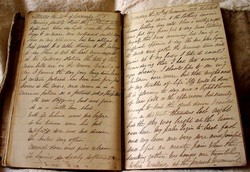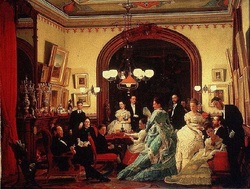 Diary of Joseph Jenkins 1878, an immigrant to Australia. Source Wikimedia. Copyright Brian Jenkins.
Diary of Joseph Jenkins 1878, an immigrant to Australia. Source Wikimedia. Copyright Brian Jenkins. But that's not what brought about this conversation. Rather we were talking about moving. Yes, moving out of the house we have lived in for over 18 years so we could downsize. But what to do with all the junk we have collected over the years, our children's art work, my great aunt Olive's wing-back chair that my mother insists I keep, and the 30 some years' worth of diaries I have kept in a trunk in my basement. What do I do with those angst-filled pages from my youth?
What was so serendipitous about this conversation was that over lunch today my children and I were talking about Anne Frank's diary. How, we wondered, did she hide it? And who discovered it? I forgot this particular story, will look it up later.
The point is that diaries tell us a lot. But more so, they tell us what people did not want us to know. William's diary for example: Bernice's prologue is very detailed. In it, she states that many pages were ripped out from his trip in 1873. This was the year of the Great Panic, like our Great Depression in the 1920s, people had over-invested, this time in railroads, and many lost fortunes, including the Durants. While he was in Egypt, William was summoned back to England where his father was waiting to tell him he must come back to America and help rebuild the family fortune.
I can't help but wonder if years later William re-read his diary entries from this stressful period of time and decided to rip out anything that would have shed a bad light on his family's situation, and then kept the rest for prosperity.
And his sister Heloise Durant Rose (Ella) refers in her court testimony during the lawsuit against her brother William (1903) to a journal she kept daily. Where, I wonder, is it? Does a collector own it? It is not with the Syracuse University collections of her correspondence. Did she burn it? Was it too scandalous perhaps and her son Durant Rose burned it?
Interestingly, my story of the Durants includes a diary. It is entirely made-up of course. It belongs to Minnie - William's supposed mistress of the woods. It was so fun to write as it allowed me to look at what was going on in 1893 through the eyes of a 17 year-old governess-turned mistress.
Not having the primary sources, like Ella's journal, leaves a lot to speculation. Although I love the research, the loose ends allow me to use my imagination.

 RSS Feed
RSS Feed
